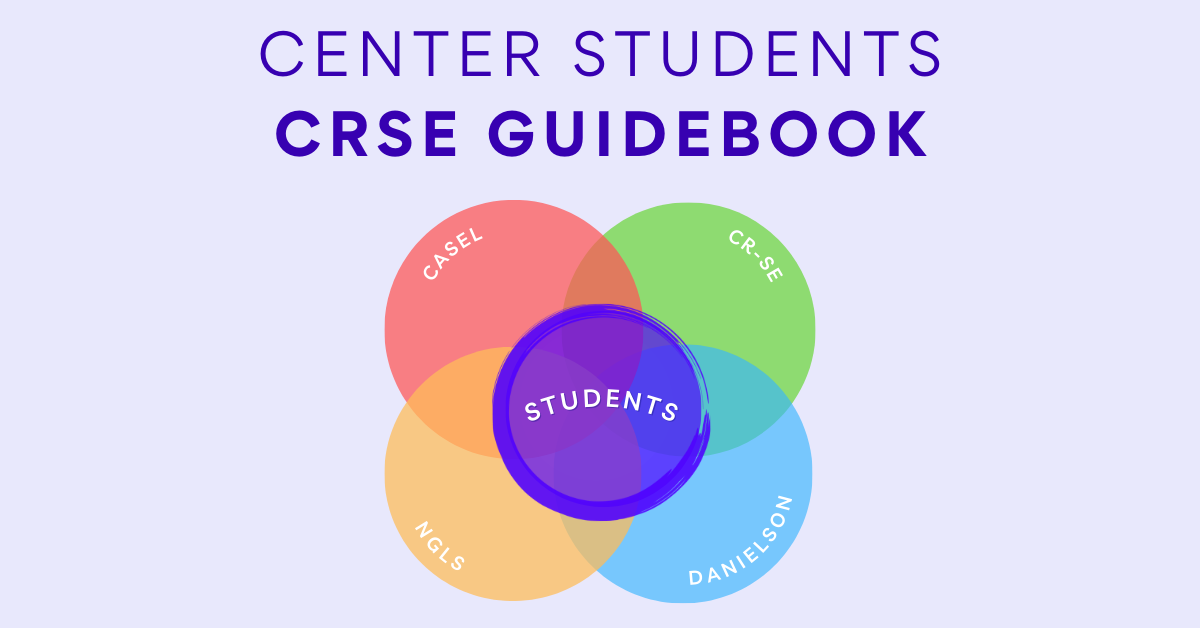|
Create a space where each student sees themselves as someone who belongs, someone who matters, someone with value.
This article is part of our Close Up On CRSE series
One of our core principles is rooted in culturally relevant, responsive, and sustaining pedagogy. We understand that we can’t separate an individual’s identity from their history, their language, their culture, beliefs, or values. As human beings, when we feel seen, heard, and valued, we are more open and engaged. It’s easier for us to feel safe, take intellectual risks, and be open to making mistakes. This is why creating a “Welcoming and Affirming Environment” is the first principle in many CRSE frameworks. But what does that mean, exactly, when it comes to classroom teaching, and what can educators do to create this kind of space?
Building a sense of belonging
In Centering Students: A Deep Dive into CRSE-Aligned Practices — a guidebook we co-designed to analyze CRSE principles and attributes — we investigate what CRSE looks like in practical, pragmatic terms, in the real world. Let’s take a close up look at Welcoming and Affirming Environments: Affirms Diverse Identities.
The notion of an affirming space is important within this attribute. We think about affirm as distinct from tolerate — as in, to acknowledge something exists even though we may not appreciate or approve of it. Affirm is also distinct from accept, which again means we simply acknowledge that the diversity may exist, and may or may not take a stance on whether or not it is of value. To affirm is to be overtly clear that our students are welcomed and valued, and since we cannot separate the individual from their identity, it means their cultural background, spoken languages, values, and beliefs are also welcomed. The NYSED CRSE Framework corroborates this concept by stating that schools are “a space where people can find themselves represented and reflected,” and the CASEL Social-Emotional Framework describes the importance of “integrating personal and social identities” as a critical component of self-awareness. As we describe it, these are spaces that integrate positive linguistic (language), gender, and cultural identities into classroom instruction (how we teach) and curricular materials (what we teach). Affirming diverse identities isn’t only about cultivating the social-emotional connections that help students feel a sense of belonging in the community. It’s also a key component of effective instructional practices, as outlined by the Danielson Framework. Danielson’s domains in content & pedagogy and classroom environment state that “teachers convey that they are interested in and care about their students” and “students feel respected; their dignity is not undermined.” If we’re interested in maximizing learning opportunities for our students, then we want to be conscientious of the benefits of belonging in the learning community. This is true for all of us, but especially for students who identify with cultures that are underrepresented. There is no recipe for affirming student identities, but there are many small entry points that we can locate as we explore small ways we can proactively affirm students’ identities and create a community that celebrates diversity.
Get curious
When making an effort to affirm identities, words matter. It isn’t enough to simply be non-offensive, especially in spaces where we have a historical backdrop of negative bias. What actions can we take to accept and respect who our students are, and build positive connections with them?
Words matter:
Get concrete
How can I acknowledge and affirm the languages represented in my class?
How can I acknowledge and affirm the language my students’ families speak?
How can I affirm youth language in positive ways?
How can I set norms for student-to-student communication?
Get clear
When we observe or overhear students (or adults) using offensive or harmful language or behaviors, it can be a surprising and disorienting experience that sometimes creates an instinctual flight, fight, or freeze reaction. If we can get clear about the ways we will treat our students, and how we expect them to treat one another, we can prepare our responses when harmful ideas are brought into safe spaces.
We want to maintain a grounded presence and offer clear guidance that helps students course correct and that diffuses any potential conflicts. We recommend that teachers work in collaboration with co-teachers or teams to develop a response plan so that when these moments arise, they can be addressed quickly and consistently across classrooms. Whether you’re creating your response plan individually or with a group, here are a few things to consider:
Depending on the situation, addressing harmful language and behaviors can be a simple reminder of the expectations, or may need more in-depth support for conflict resolution or personal reflection to better understand the harm that’s been caused. Work with guidance counselors or social workers to support these more serious situations.
Affirming diverse identities is a challenge to see our students beyond where they sit, the clothes they wear, or their latest hairdo. It’s an opportunity to get to know them beneath the surface, and the privilege to create a space where they see themselves as someone who belongs, as someone who matters, as someone with value.
When they experience this level of community-building, it’s easy to learn. |
|
The Center for Professional Education of Teachers (CPET) at Teachers College, Columbia University is committed to making excellent and equitable education accessible worldwide. CPET unites theory and practice to promote transformational change. We design innovative projects, cultivate sustainable partnerships, and conduct research through direct and online services to youth and educators. Grounded in adult learning theories, our six core principles structure our customized approach and expand the capacities of educators around the world.
|
ABOUT US
525 West 120th Street, Box 182 New York, NY 10027 416 Zankel Ph: (212) 678-3161 [email protected] Our Team Career Opportunities |
RESOURCES
Professional Articles Ready-to-Use Resources Teaching Today Podcast Upcoming PD Opportunities |
COACHING SERVICES
Custom Coaching Global Learning Alliance Literacy Unbound New Teacher Network Student Press Initiative |


























